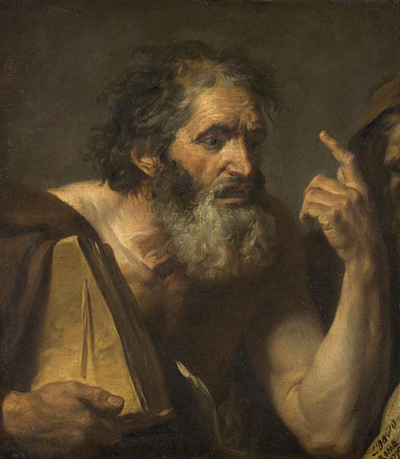This painting is an early portrait from Jacques Louis David. Although it carries his signature in the lower right corner, there is evidence that the composition has been altered after his initial work.
We find here an elderly gentleman with his finger in the air. He looks concerned and also holds a thick manuscript under his right arm. His clothes are simple, suggesting either a religious role or someone who has fallen upon hard times. His beard and hair look untidy too. To the right hand side is a hooded man who is partially cropped out of the scene. This alerts us to the likelihood of the canvas having been reduced in size after the artist's work has been completed, as he would never have planned a piece that left a figure only half way in view. It may have been that other elements of the scene had been left incomplete, and so the decision was taken to use only the completed part. Additionally, the composition is very different to his earlier single portraits, with the figure looking away to the side and much of his own frame also out of view.
The two genres in which David would become most famous would be portraiture and history painting. This scene clearly captures a little bit of both. He used Greek literature as inspiration for many of these scenes and loved to add strong emotions into his work by depicting scenes of tragedy. His portraits tended to be complementary pieces, often of women. Early on, they would be of friends and family as he started to spread his influence into the upper levels of society, after which he would then start to receive a steady stream of high paying commissioned work.
Ancient Philosopher, 1779, is now a part of the collection of the Museum of Baron Gerard in Bayeux, France. This institution is believed to have been set up originally by Baron Henri-Alexandre Gérard (1818-1903), whose father was actually a pupil under the tutorship of Jacques Louis David. The set of museums found in this town are, of course, most famous for being the home to the Bayeux Tapestry, though there is also plenty of other items worth taking a look at. Local pottery and lace design can be found here as well as original paintings from the likes of Portraits in the Countryside by Gustave Caillebotte and also The Cage by Francois Boucher. There is lots to see across the different venues, to suit all tastes and the selection is probably aimed at tourists who are looking for a general overview of the cultural offering of the local region, as well as an opportunity to see the tapestry in person.




